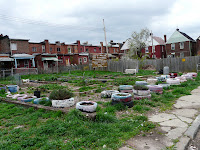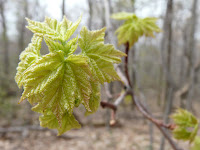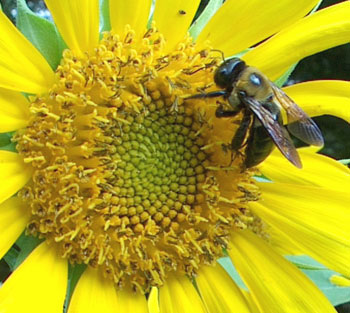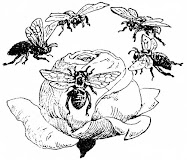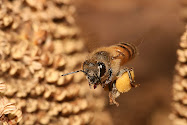
Photo: Muhammad Mahdi Karim - see (1) below
Bees have been around for millions of years. Cave paintings in Europe show people harvesting honey 8,000 years ago! Bees have an amazing ability to find the best flowers for their food, so no wonder they have been around for so long.
 Bees see with eyes, just like humans see with eyes, but unlike humans, bees' eyes are compound. That means, inside each compound eye are hundreds of single six-sided eyes arranged next to each other, side by side. Each of these six-sided eyes has its own lens. Each of these lenses is looking in a different direction. Whatever the bee is looking at, each lens adds a piece to the whole image. Think about a puzzle. Initially, there are many pieces that make up the picture. Looking at the pieces, you might see a lot of different shapes and colors. When the pieces are all in place, all put together, you see one complete picture or image. The bee's compound eye works in the same way.
Bees see with eyes, just like humans see with eyes, but unlike humans, bees' eyes are compound. That means, inside each compound eye are hundreds of single six-sided eyes arranged next to each other, side by side. Each of these six-sided eyes has its own lens. Each of these lenses is looking in a different direction. Whatever the bee is looking at, each lens adds a piece to the whole image. Think about a puzzle. Initially, there are many pieces that make up the picture. Looking at the pieces, you might see a lot of different shapes and colors. When the pieces are all in place, all put together, you see one complete picture or image. The bee's compound eye works in the same way.Bees can see shapes, but see colors differently than humans. Their vision is pretty sharp or clear for the distance of about three feet.
Photo: Ralph Grimm - see (2) below
Bees can also see ultraviolet light that the human eye cannot see. The ultraviolet light uncovers colors and patterns in flowers that attract the bee to its source of pollen and nectar. Ultraviolet light makes for content, happy bees because the pollen and nectar give the bees energy to do what they do best - make sweet honey!
So, the next time you see one bee, remember: there are a couple hundred eyes looking back at you! ~ Mary Anne Watson
~ Page 2 ~
ABOUT THIS MONTH'S PHOTOGRAPHS:
(1) This photograph, "Apis mellifera flying," was taken by Muhammad Mahdi Karim, a Tanzanian student living in Bangalore, India. To see more close-ups of bees and other insects, visit his website at http://www.micro2macro.net/. (Required Note: Permission is granted to copy, distribute and/or modify this document under the terms of the GNU Free Documentation License.)
(2) This photo, "Eye of a honeybee," is by Ralph Grimm of Jimboomba, Queensland, Australia, and won an Honorable Mention in the 2008 Olympus BioScapes Digital Imaging Competition. All the entries use light microscopes to capture incredible images from the world of nature. You can read more about the competition and see a slide show of the winning photos for 2008 at the online site for Scientific American: http://www.scientificamerican.com/article.cfm?id=bioscapes-contest-photos. And here's the link for the 2009 photos: http://www.scientificamerican.com/article.cfm?id=illuminating-the-lilliputian-bioscapes-winners.
 Check out scientist Andy Giger's webpage "B-EYE: See the world through the eyes of a Honey Bee" for some pretty amazing images: http://andygiger.com/science/beye/beyehome.html.
Check out scientist Andy Giger's webpage "B-EYE: See the world through the eyes of a Honey Bee" for some pretty amazing images: http://andygiger.com/science/beye/beyehome.html.Below left and right:
Einstein how we see him . . . . and here he is from a bee's eye view - cool!

Do bees recognize human faces? Read the article from Science magazine: http://news.sciencemag.org/sciencenow/2005/12/02-02.html.
Do bees see in color? The dandelion on the left is how we see the colors; the one on the right is how a bee sees the same dandelion.
"Ultraviolet light, invisible to us, uncovers colours and patterns which draw them to the source of pollen and nectar - all hidden to humans without special equipment. This secret colour world was discovered in the Fifties and scientists realised that these distinct patterns were designed to act as "landing strips" or arrows, guiding the insects to the right spot."
Read more about it online: http://www.dailymail.co.uk/sciencetech/article-473897/A-bees-eye-view-How-insects-flowers-differently-us.html.


































 Left: Robert passes the hive tool to Joan
Left: Robert passes the hive tool to Joan
